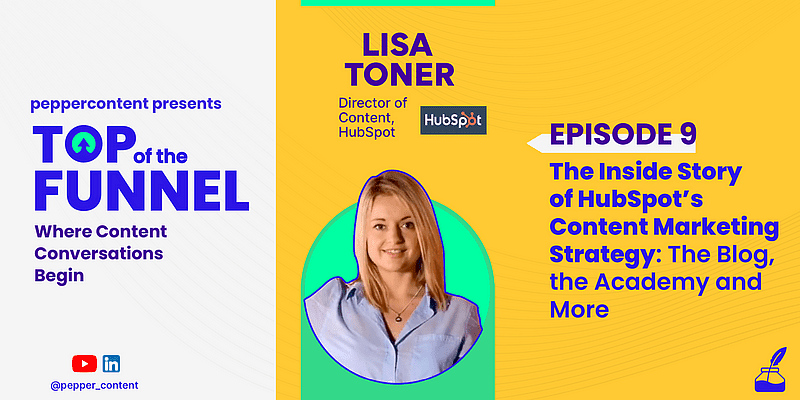A few names have become synonymous with ‘content marketing’, and HubSpot is one such organisation. With reams of valuable content out there on their blog, disseminated for free via the HubSpot Academy and more, HubSpot has almost been the school that every aspiring content marketer has attended, virtually.
In this week’s episode of Pepper Content’s Top of the Funnel, Natasha Puri, Content Marketing Lead at Pepper, caught up with Lisa Toner, Director of Content at HubSpot.
WATCH THE VIDEO
Building a hands-on content marketing team
The blogging team at HubSpot consists of 14 writers with an editor for each blog property and a manager over them. An independent teammate is in charge of studying the conversion from the blog and he or she maps out the conversion path from blog reader to customer.
Another big focus off late for Lisa’s team has been the YouTube channel. A scriptwriter works on the channel and they see a big benefit in converting high-performing blog content into videos.
“The benefits of this are two-fold: your Google ranking improves, and as your YouTube views increase, you will also likely rank in the video carousel in the Google Search Pages for video,” says Lisa.
Content marketing challenges and how to beat them
Lisa feels that in creating a result-oriented approach to content marketing, creative content creators are not very analytical. But the reality is that analytics can actually help creators.
“Look at the analytics of your YouTube video and see where people are dropping off. This is the point that can be changed and tested to see what really works,” explains Lisa, who believes that using data can actually help creators make better content.
Another major challenge is Google’s fluctuating algorithm. Whenever it changes you see a big dip in traffic – something that feels completely out of your control. This eventually impacts the team’s morale as well.
The way to tackle this effectively is constantly updating and refurbishing content guidelines as per Google and ensuring that the team is made aware that their efforts are appreciated and this message must come from the leadership.
The lifecycle of a blog and its impact on Google rankings
An important insight that Lisa shares is how rankings change based on the maturity of the blog and the growth stage you are in. For instance, “during the seeding stage of a blog when it is new, the number of posts impact rankings and during the growth and maturity stage, it is about updates.”
HubSpot’s marketing blog has been around for a while, their strategy is deeply focused on making the existing posts more comprehensive and constantly updating content that is even older than six months.
For new blog properties, the first few months could mean havoc with a lot of fluctuations. However, for more matured blogs, new updates mean an immediate surge in rankings that could drop after some time. It takes about three to six months to see the rankings become steady, she informs.
Tips for creating a lean mean content marketing machine
The biggest tip that Lisa has to share with us is to ensure alignment across all teams. For this, she suggests creating a shared editorial calendar across all content teams including YouTube, blog, podcast, etc., so that everyone is aligned and unified in their messaging and can collaborate with each other on upcoming content pieces.
- Don’t keep reinventing the wheel and concentrate on updating your existing content. This has been very impactful for HubSpot and the majority of their leads come from posts that are six months or older.
- Find scalability by creating one long piece of content like an interview or ebook and then repurpose it into social media posts, podcasts, blogs, etc. Take a cue from Gary Vee!
Advice for enterprises
For any enterprise businesses to venture into content marketing, Lisa informs of two major learnings:
- Have an in-depth understanding of your buyer persona. “Creating a proper persona took my content to a whole new level. Constantly question, will this persona be excited to view your content,” she explains.
- Actively work at breaking down silos. They are dangerous since it means that teams are working individually and not cross-collaborating. This also means there is duplication of efforts, and misalignment of the company’s messaging.
The classic love story between sales and marketing
For such a huge content marketing team at HubSpot, aligning with the sales team could be a task. Lisa feels that it is all about communication and about asking the sales team what they want and set expectations about what content solves which purpose so that it is effective.
For example, a blog will have less product-oriented content because the focus is on discovery and talking about customer pain points. However, there can be a case studies library on the website, which is more directly useful to sales teams.
The HubSpot Academy Story: User acquisition through content
The free courses offered by HubSpot Academy are a great way to get prospects interested through high-quality, valuable content. But this content doesn’t sell the product to them, making it all about learning. The seamless integration of courses that allow you to ‘practice what you have learned’ using HubSpot tools, proves an effective, non-invasive way to acquire new users.
“We have two types of courses — one is product-agnostic that doesn’t promote our software like ‘How do you do this?’ And then we have ones that say ‘How do you do this with our software?’ These are also application based where users can try what they have learned. So people can see the value of the product before they spend money on it. These clients also stay with us for longer,” she says.
(Disclaimer: The views and opinions expressed in this article are those of the author and do not necessarily reflect the views of YS.)










